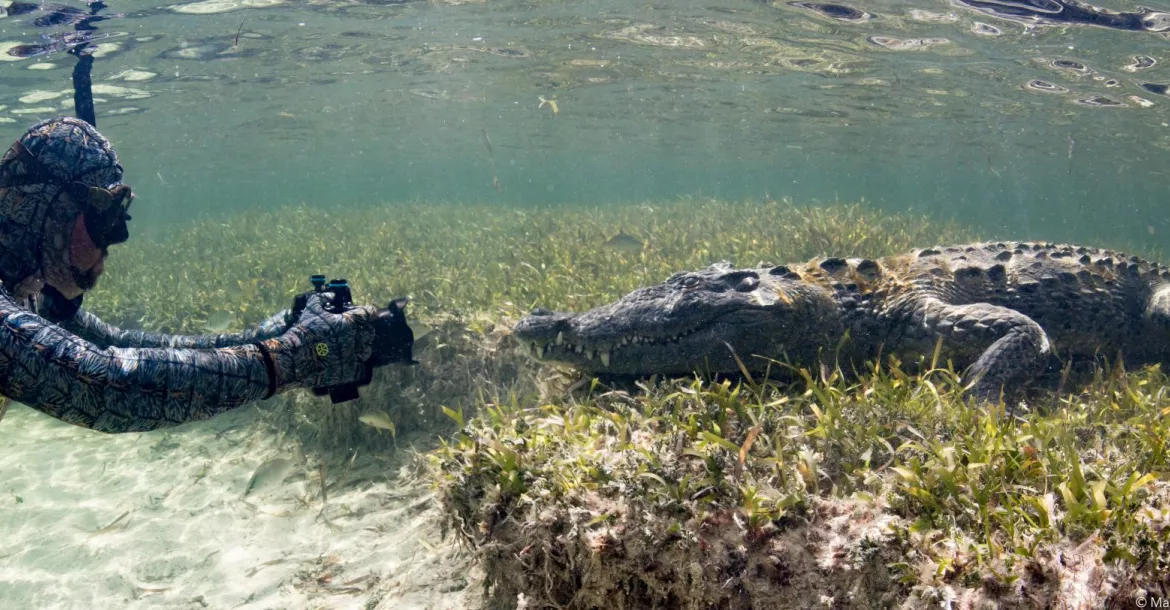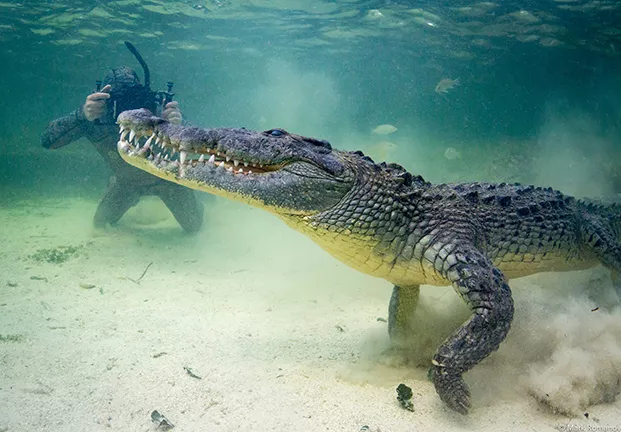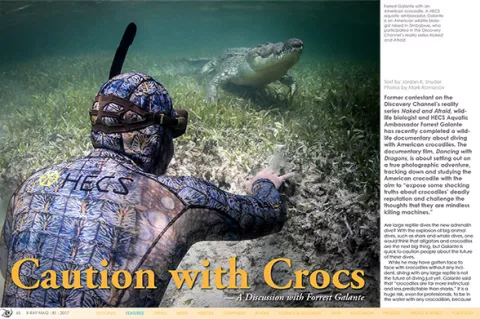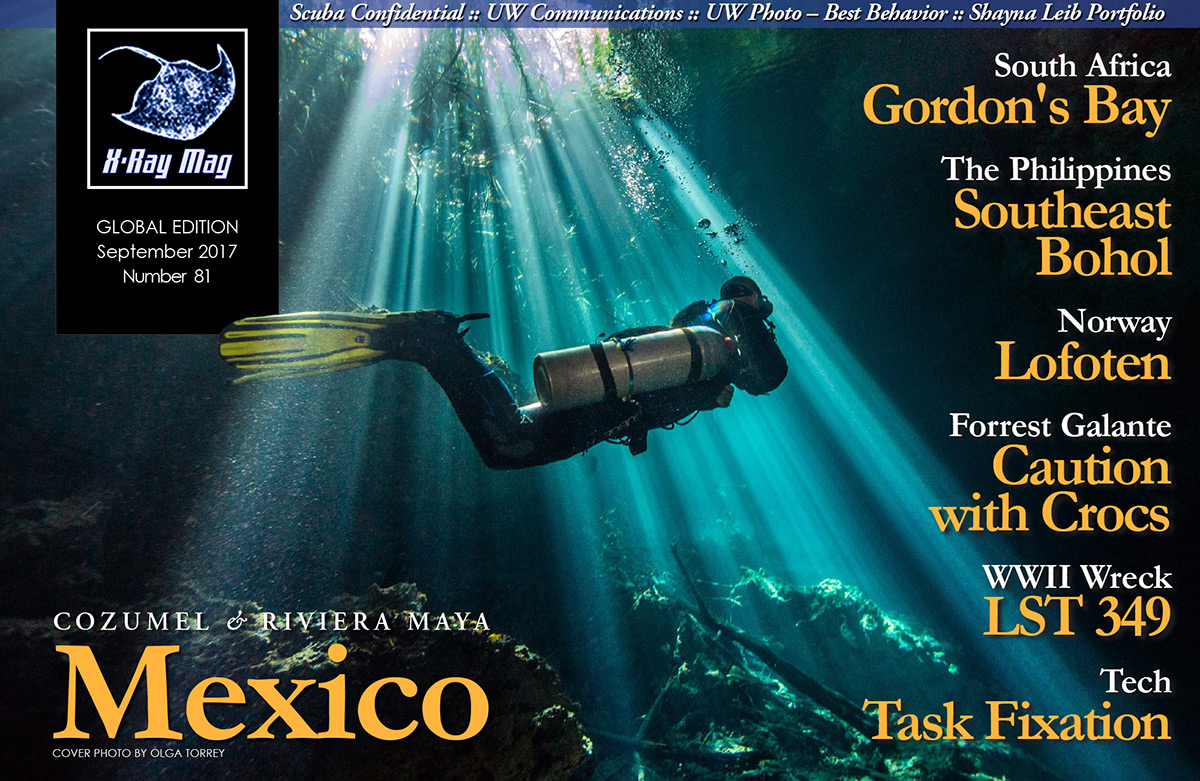Former contestant on the Discovery Channel’s reality series Naked and Afraid, wildlife biologist and HECS Aquatic Ambassador Forrest Galante has recently completed a wildlife documentary about diving with American crocodiles. The documentary film, Dancing with Dragons, is about setting out on a true photographic adventure, tracking down and studying the American crocodile with the aim to “expose some shocking truths about crocodiles’ deadly reputation and challenge the thoughts that they are mindless killing machines.”
Contributed by
Factfile
Jordan Snyder is a law student in South Florida with a background in biology.
He is also a freelance journalist focusing on pressing environmental and conservation issues as well as an amateur wildlife photographer.
For more information on his previous articles and photography, please visit: https://jksnyder1.wixsite.com/thereefdonkey.
Are large reptile dives the new adrenalin dive? With the explosion of big animal dives, such as shark and whale dives, one would think that alligators and crocodiles are the next big thing, but Galante is quick to caution people about the future of these dives.
While he may have gotten face to face with crocodiles without any incident, diving with any large reptile is not the future of diving just yet. Galante said that “crocodiles are far more instinctual and less predictable than sharks.” It is a huge risk, even for professionals, to be in the water with any crocodilian, because its “mood” can change instantly due to a number of variables, such as daily conditions or other animals in the area.
Growing up in Zimbabwe and watching Nile crocodiles attack large wildebeest, and even some of his family’s safari staff, Galante learned quickly that if any crocodilian has an advantage, it will be taken, because they will always view people as prey. People must not overlook that they are extremely efficient killers, and it is very easy for them to switch directly into “predator mode”.
Eco-tourism
Despite the caution advised by Galante and many other wildlife biologists, there is a growing industry in diving with alligators and crocodiles, one of which most notably is Banco Chinchorro in Mexico. Banco Chinchorro has a growing eco-tourism business offering dives with the American crocodile. It is the same species that Forrest’s documentary film follows, which has no history of attacks of note on any tourists.
“I [am] ... a little surprised there has not been an incident yet, but ... the conditions are absolutely ideal for engagement [there],” said Galante. “That being said, I think it only takes a few people not paying attention, or rather acting in a manner that is not respectful enough, for there to be a big accident.”
Safety
While crocodilians like the ones in Banco Chinchorro might be habituated to humans, this does not mean that they are incapable of injuring a tourist. Even Galante admits that he maintains a healthy sense of caution and distance entering the water with these apex predators as a means of assessing the situation; this may not be the same approach taken by the average diver.
This is a new diving endeavor, and it may take some time to find a safe way to enjoy these amazing predators in the water, such as possibly “diving in a cage from a boat or platform.” A barrier between the animal and diver would ensure safety on both sides.
Galante does believe that, in the future, there could be an eco-tourism industry built around crocodiles and alligators. But, in the meantime, it is not recommended that people attempt any of these types of dives, to avoid the likelihood of injury. Galante does recommend that everyone should enjoy these modern dinosaurs, but from a safe distance.
A special wetsuit
As an ambassador of HECS Aquatic, Galante has proudly used HECS wetsuits for conservation efforts and spearfishing. What makes a HECS wetsuit different from other wetsuits is its technology, which is based on the Faraday cage. This helps to enhance a diver’s experience in getting closer to marine life by keeping all the electrical signals emitted by the human body within the suit.
Galante used a HECS wetsuit with a specially-created crocodile scaled pattern, based on the assumption that it might make the crocodiles more comfortable. “The theory was by looking like a crocodile and acting like a crocodile, we might actually be a little bit safer and be able to get closer to the crocodiles,” said Galante. “There is no current scientific data to suggest crocodiles can detect electrical signals, you just never know, as this is an area of science that is very unexplored. By wearing suits that block the body's electrical current and mimicked the animals’ scaly patterns, we hoped to capture the reptile's natural behavior in a more unaltered state.”
On the horizon
Currently, Dancing with Dragons is being submitted to roughly 50 film festivals. In the meantime, Galante does have another independent wildlife film in the works featuring cold weather animals. Keep an eye on his social media pages, because Galante is always performing exciting tests with the HECS technology on different animals around the world. ■
Thanks go to Forrest Galante and Mark Romanov for their time and contributions to this article. For more updates and pictures of Forrest Galante’s latest adventures, go to: ForrestGalante.com or follow him on Instagram @ forrest.galante. For more information on HECS wetsuits and technology, please visit: HECSAquatic.com.






























